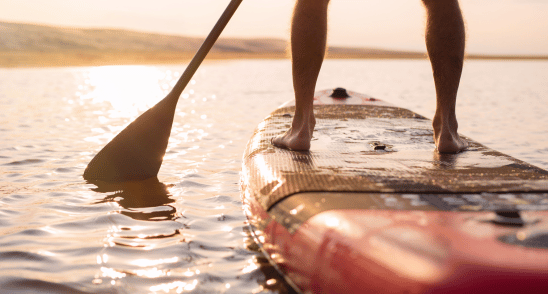Paddleboarding and yoga are two activities
that promote physical and mental well being. Combining the two into one `paddleboard
yoga` offers a unique and exhilarating experience.
If you`re seeking a way to connect with
nature, challenge your balance, and deepen your yoga practice, paddleboard yoga
with Bote
Board is the perfect fusion.
This blog post will explore the art of
mastering paddleboard yoga, highlighting the benefits, recommended poses, and
safety precautions to help you make the most of this great practice.
1. Understanding Paddleboard Yoga:
Paddleboard yoga, also known as SUP yoga
Stand Up Paddleboard Yoga, takes the traditional yoga practice onto a floating
platform the Bote board. This practice offers a special connection with nature
as you perform yoga poses on calm water bodies such as lakes, rivers, or the
ocean. The instability of the board challenges your balance, engages your core
muscles, and forces you to be present at the moment.
2. The Benefits of Paddleboard Yoga:
a.
Core Strength and Stability: Paddleboard yoga requires constant engagement of your core muscles
to maintain balance on the board. Regular practice strengthens and tones your
core, improving stability and posture.
b.
Improved Focus and
Mindfulness: Performing yoga on a moving surface
demand heightened focus and presence. Paddleboard yoga teaches you to find
inner stillness, helping you cultivate mindfulness on and off the water.
c.
Enhanced Flexibility and
Balance: The unstable surface of the board engages
small stabilizer muscles, challenging your balance and improving overall
stability. It also increases flexibility as you adapt to the moving surface
during different poses.
d.
Connection with Nature: Paddleboard yoga immerses you in nature, providing a serene and
peaceful environment that promotes a deeper relationship with the natural
world.
3. Preparing for Paddleboard Yoga:
a.
Choose the Right Paddleboard: Bote
offers various paddleboard models suitable for yoga. opt for wider and more
stable boards, such as the Bote HD, Rover, or Flood, which provide ample space
for yoga poses.
b.
Find Calm Waters: Look for calm, still waters without strong currents or heavy boat
traffic. Lakes, lagoons, and calm bays are ideal for paddleboard yoga sessions.
c.
Wear Appropriate Attire: Dress in comfortable and flexible clothing suitable for yoga.
Consider wearing a bathing suit or quick drying attire, as you might get wet
during practice.
d.
Safety First: Always wear a personal flotation device PFD and attach a leash to
your ankle or waist to ensure you stay connected to the board. Be aware of
weather conditions and consult local guidelines for water safety.
4. Essential Paddleboard Yoga Poses:
a.
Mountain Pose Tadasana: Stand tall on the board, feet hip width apart, and focus on
grounding through your feet. Engage your core and find balance as you extend
your arms alongside your body.
b.
Warrior II Virabhadrasana II: Take a wide stance with one foot towards the front and another
pointing sideways. Bend the front knee, align it with your ankle, and extend
your arms parallel to the ground. Engage your core for stability.
c.
Downward Facing Dog Adho
Mukha Svanasana: Position your hands on the board,
shoulder width apart, and walk your feet back, forming an inverted V shape.
Engage your core, press your hands firmly into the board, and stretch through
your back and hamstrings.
d.
Tree Pose Vrikshasana: Shift your weight onto one foot and place the other on your
standing leg`s inner thigh or calf. Find a focal point to assist with balance
and engage your core. Optionally, extend your arms overhead or keep them at
your heart centre.
e.
Savasana Corpse Pose: Lie on your back on the board, arms by your sides, palms facing up.
Close your eyes and let your body relax completely, surrendering to the gentle
movements of the water.
5. Tips for a Successful Paddleboard
Yoga Practice:
a.
Start with Basic Poses: Begin with simple poses focusing on balance and stability before
attempting more advanced ones.
b.
Modify and Adapt: Modify poses to suit the instability of the board. Use the paddle
for support if needed, or widen your stance to improve stability.
c.
Engage Your Core: Maintain a strong core throughout your practice to stabilize
yourself on the board.
d.
Focus on Your Breath: Concentrate on slow and controlled breaths to enhance your balance
and relaxation.
e.
Embrace Falling: Falling into the water is a part of the paddleboard yoga
experience. Embrace it with a sense of humor and see it as an opportunity to
let go and laugh.
Mastering paddleboard yoga with Bote
Board offers a transformative experience that combines the benefits of
yoga with the serenity of being on the water. By embracing the challenge of
balancing on an unstable surface, you deepen your core strength, improve
balance and flexibility, and enhance mindfulness. Whether you`re a seasoned
yogi or a paddleboarding enthusiast looking to add a new dimension to your
practice, paddleboard yoga with Bote Boards is an incredible journey of self discovery,
harmony, and connection with nature. So grab your Bote board, find a calm water
body, and embark on this transformative yoga adventure. Namaste!

Comments